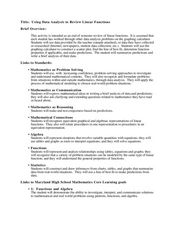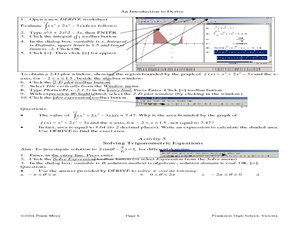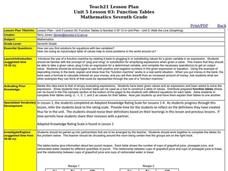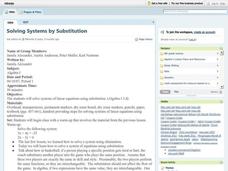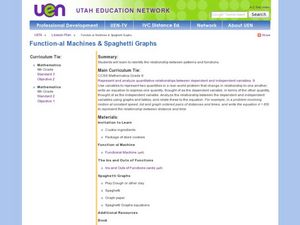Curated OER
Points in the Complex Plane -- Lab
Students review the lecture portion of this lesson. Individually, they graph various points on a complex plane and identify conjugates based on their location on the graphs. They complete a worksheet and review their answers to end the...
Curated OER
Dancing Number Sentences
Students explore how dance can be infused with mathematics. In this art and mathematics lesson, students recognize how the ABA dance form is similar to a math number sentence. Students create a dance choosing dance words to represent...
Curated OER
Using Data Analysis to Review Linear Functions
Using either data provided or data that has been collected, young mathematicians graph linear functions to best fit their scatterplot. They also analyze their data and make predicitons based on the data. This lesson is intended as a...
Curated OER
An Introdcution to Derive
Twelfth graders explore Derive. In this Calculus lesson, 12th graders investigate the menus and tools available in Derive. In addition to the familiarization part of the lesson, students investigate Pascal’s Triangle,...
Curated OER
Linking Length, Perimeter, Area, and Volume
Students explore measurements of rectangles. In this measurement comparison lesson, students discover the length, width, perimeter, and area of two different rectangles. Students record their measurements on a chart to make comparisons.
Curated OER
Function Tables
Students identify function using tables of data. In this algebra lesson, students create a tale of point and plot on a coordinate plane. They analyze the graph as being a function or not.
Curated OER
Using CAS and algebra tiles with Expanding and factoring trinomials
Ninth graders investigate multiplication of binomials and factoring of trinomials. In this Algebra I instructional activity, 9th graders compare and contrast expansion and factoring using algebra tiles and a TI-89.
Curated OER
Computing with Mathematical Formulas
Students solve problems using formulas. In this algebra lesson, students evaluate numbers using substitution. They graph their answers using a TI and discuss the outcome.
Curated OER
Describing Patterns
Fourth graders investigate repeating and growing patterns. Models, graphs and words are used to describe, extend and represent patterns. Students use evidence from models and graphs to support the identification of patterns.
Curated OER
Solving Systems by Substitution
Students solve systems of linear equations using substitution. They investigate the steps to solving linear equations by substitution and practice problems in small groups.
Curated OER
Function-al Machines and Spaghetti Graphs
Sixth graders identify the relationship between patterns and functions. For this algebra lesson, 6th graders use a "Functional Machine" to identify the rule. Students use a function table to plot the points using play dough dots.
Curated OER
Using Inequalities to Problem Solve
Young scholars explore inequalities. In this Algebra I lesson plan, students solve and graph linear inequalities involving addition, subtraction, multiplication, or division. Young scholars use inequalities to solve and graph...
Curated OER
Model Data with Quadratic Functions
Students model data using quadratic equations. In this algebra lesson, students simplify and factor quadratic equations. They graph the function using collected data and analyze the parabola.
Curated OER
Two-Step Equations
Sixth graders work through a two-step equation with their teacher. After reviewing one-step equations, they complete a worksheet using tiles and colored pencils to complete two-step equations. To end the lesson, they write out the step...
Curated OER
Two Step Equations
Sixth graders solve multiple step math problems. In this problem solving lesson, 6th graders practice following step by step instructions such as making cookies or building a snowman. Students use algebra tiles and draw pictures to solve...
Curated OER
Introduction to Linear Functions
Students are introduced to the concept of linear functions. Using new terminology, they describe linear functions in sentences and in data tables. Using the internet, they calculate and record answers to problems which are discussed...
Curated OER
What's My Function?
Pupils use input / output tables to help them solve algebraic equations. They use patterns and relations to represent and analyze mathematical situations using algebraic symbols.
Curated OER
What's My Function?
Fifth graders utilize input/output tables to help them solve algebraic equations. They incorporate patterns, number sequences and relations to represent and analyze mathematical problems and number relationships using algebraic symbols.
Curated OER
Equations, Formulas and Identities
Students rewrite word problems using the correct symbols. In this algebra lesson, students find the trigonometric identities and use them to solve problems. They write equations for the trigonometric ratios.
Curated OER
Introductory Exponents
Pupils participate in a lesson combining language arts with mathematics. First, they write a paragraph explaining what it means to multiply two numbers. Then students practice using exponents in different problems.
Curated OER
Identity and Equality Properties: Pages 37-43
In this math worksheet, students use a list of mathematical properties in order to justify their evaluations. Students name multiplicative inverses and properties illustrated in 13 numbers and statements.
Curated OER
Building a Rover
Students investigate properties of lines and points by making a rover. In this algebra lesson, students plot points correctly on a coordinate plane. They identify coordinate pairs given the plots and lines.
Curated OER
The football and Braking Distance; Model Data with Quadratic Functions
Students use the quadratic formula to solve application problems. The first problem relates to the path of a football thrown from the top of the bleachers. Students compute the time it will take the football to reach certain heights. In...
Curated OER
Pigs, Goats and Sheep
Student are able to devise and use problem solving strategies to explore problems systematically and mathematically. They also form and solve various types of equations. This lesson plan requires some prior knowledge of equations.


